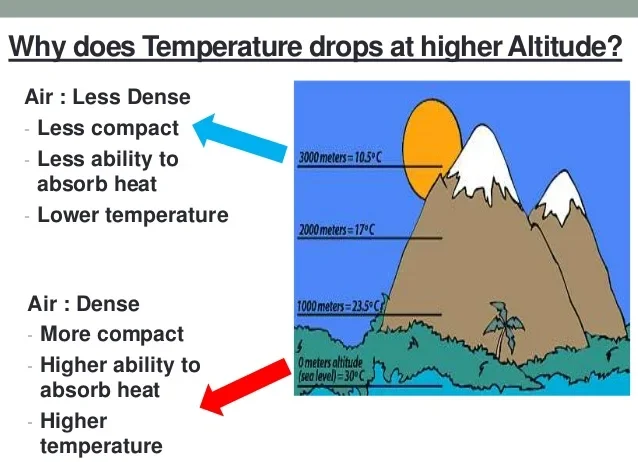Elevation plays a crucial role in shaping our environment, influencing everything from local ecosystems to global weather patterns. As one ascends in altitude, a noticeable shift occurs in atmospheric conditions, primarily due to changes in temperature, air pressure, and humidity. Have you ever wondered why the peaks of mountains are capped with snow while the valleys below bask in warm sunshine? This phenomenon is a fundamental aspect of climatology and meteorology, and it raises compelling questions about the intricate interplay between elevation and the elements.
To comprehend how elevation affects heat and weather, one must first grasp the gradient of temperature change with altitude. The basic principle at play is the lapse rate, which describes the decrease in temperature as elevation increases. Typically, the Earth’s atmosphere experiences a lapse rate of about 6.5 degrees Celsius per kilometer. This reduction in temperature with height leads to a very different set of climatic conditions in mountainous regions compared to lower altitudes.
For instance, at sea level, the average temperature is around 15 degrees Celsius, whereas at an elevation of 3,000 meters, the temperature could plunge to near freezing or even below, depending on the geographic location and season. This contrast often results in the phenomenon of temperature inversions, where a layer of warm air traps cooler air at lower elevations, significantly influencing local weather patterns.
Moreover, air pressure decreases as one climbs higher, altering not only temperature but also humidity and the behavior of air masses. At higher altitudes, the air is less dense, leading to reduced heat retention. Consequently, mountains can act as barriers to air masses, forcing them to rise and cool, which can intensify precipitation on the windward side while creating arid conditions on the leeward side. This effect is known as orographic lift and is a critical factor in forming diverse ecosystems and microclimates.
As one navigates through different elevations, the presence of vegetation also varies markedly. Biomes transition from lush forests to alpine tundra as altitude increases, highlighting the impact of elevation on biodiversity. Plants and animals adapt to these starkly different environments, showcasing resilience and the ability to flourish despite the harsh conditions found at higher altitudes. Such adaptations can be observed in certain species of flora that develop specialized structures to withstand the intense winds and colder temperatures, or fauna that migrate to lower altitudes during inhospitable seasons.
But the challenges presented by elevation are not confined to flora and fauna; they extend to human societies as well. Communities residing in high-altitude regions face unique obstacles related to climate and weather. The thin air can lead to health issues such as altitude sickness, and the lower temperatures pose significant challenges for agriculture and infrastructure development. These factors necessitate that inhabitants develop innovative solutions to thrive in their elevated habitats.
When we consider elevation in the context of global climate change, the stakes become even higher. As the climate warms, the melting of glaciers and permafrost can drastically alter landscapes and water supplies for millions who depend on these resources. The consequences of elevation-related climate dynamics extend far beyond local environments, impacting global weather patterns and contributing to the increasingly volatile nature of storms, droughts, and other extreme weather events.
Yet, it poses a distinctive challenge: how can societies effectively adapt to the continual changes spurred by both elevation and climate dynamics? As the temperature rises, mountainous regions may experience alterations in ecosystems, potentially leading to the displacement of species and changes in resource availability. The need for sustainable practices becomes paramount, as does the integration of scientific research and traditional ecological knowledge to create adaptive strategies for communities globally.
Across the globe, research into high-altitude climates reveals a wealth of knowledge about past climate patterns and the prognosis for future conditions. Scientists and climate researchers study these environments to predict how we might adapt to the expanding climate crisis. Exploring how elevation affects heat and weather provides insight into larger systemic changes on our planet, urging us to recognize our interconnectedness with Earth’s diverse ecosystems.
As the layers of our atmosphere dictate weather patterns and ecological systems across varying altitudes, it becomes imperative to explore how our actions, particularly in terms of environmental degradation, exacerbate these natural phenomena. Deforestation, urbanization, and pollution can alter local climates, leading to profound consequences not only for those at lower altitudes but also for those living in elevated regions as well.
In conclusion, the relationship between elevation and atmospheric elements is a complex and multifaceted subject, encompassing temperature, air pressure, humidity, and biodiversity. The climate systems engineered by these variables serve as reminders of the delicate balance our planet maintains. Understanding this relationship fosters a deeper appreciation for the challenges we face as stewards of the environment. Addressing these challenges is not merely an environmental necessity; it is an ethical imperative that calls for immediate action. How can we collectively ensure that both mountainous regions and lowland communities adapt and thrive amid the evolving climate landscape? The journey to answer this question might very well hold the key to a more resilient future for all.




